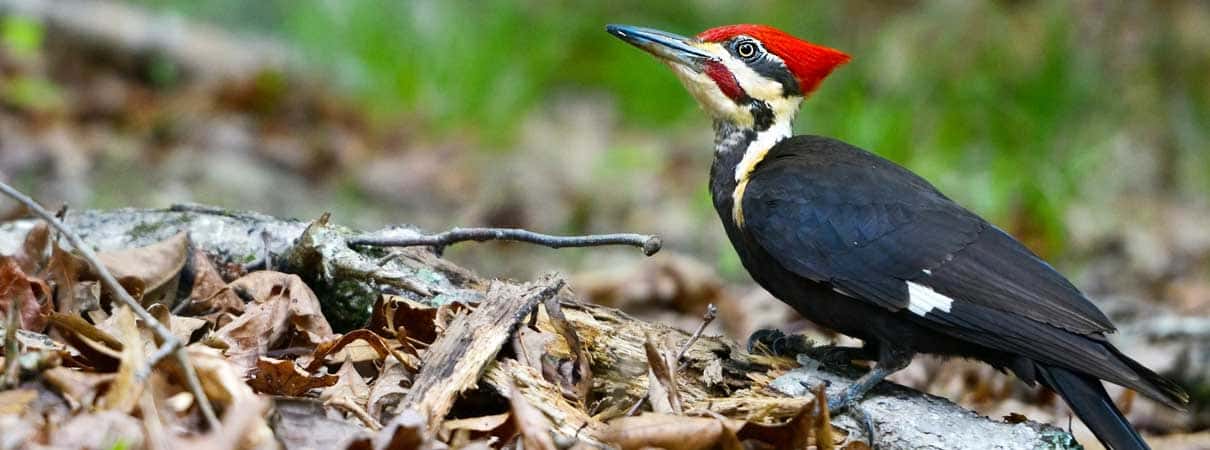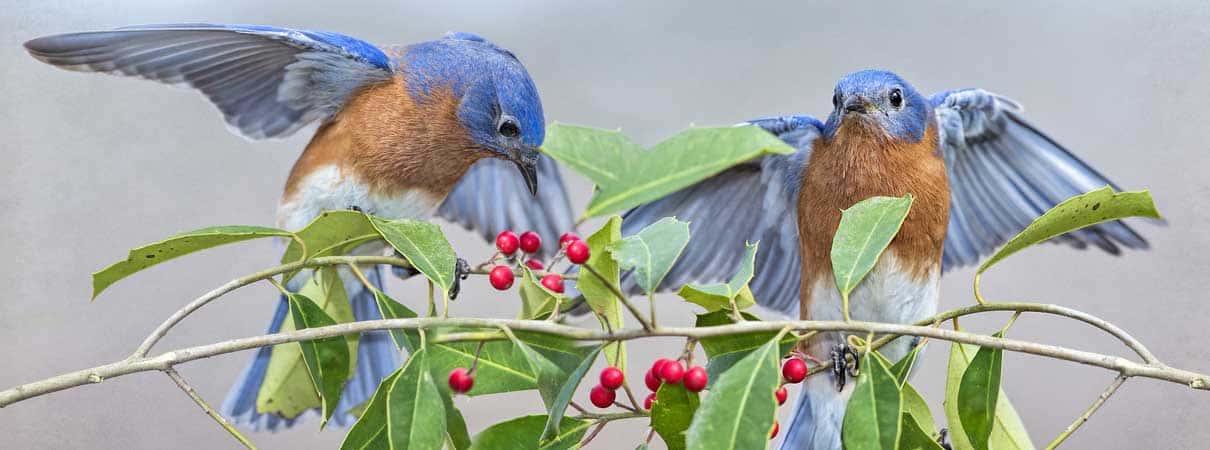Bird-friendly Garden Tips for Fall
The tanagers, orioles, and hummingbirds of summer are gone, but despite what chilly weather portends, this is a great time to intensify efforts to help birds in your garden. What you do today to provide food, shelter, and nesting opportunities will pay dividends once the days grow longer. No doubt you'll enjoy the increase in avian visitors to your yard with bird-friendly plants and gardening — but you'll also be doing your part to help counter the loss of habitat and declining populations faced by many bird species.

Pileated Woodpeckers are attracted to dead branches, especially those that are home to ant colonies. Photo by Orhan Cam, Shutterstock
1. Leave it
This “action” requires that you do nothing at all, except think about what to leave for birds and the invertebrates they feed upon and feed to their young. Here are some things to leave alone in your yard:
- Stalks and flowers that have died back from frost. Right now, many of these provide seeds and cover for birds like the White-throated Sparrow, while harboring invertebrate eggs and dormant insects and spiders that provide winter bird food as well as next spring's bird protein.
- Leaf litter, which protects invertebrates and other food for birds. Thrashers, towhees, and sparrows shuffle among the leaves to find food. Leaf litter supports a rich array of invertebrates and helps protect and enrich the soil and plant roots, while conserving moisture as a natural mulch.
- Dead snags, branches, and twigs, as long as they pose no hazard to people or structures. Snags — standing dead trees and shrubs — provide perches that birds from Cooper's Hawks to Ruby-throated Hummingbirds use to get a clear view of competitors, predators, or food. These perches also harbor wood-boring insects sought by woodpeckers. In spring, you may see nest-building birds visit snags to pull off fine strips of bark or twigs. If your snag is large enough, it may attract woodpeckers, bluebirds, or other cavity-nesters.

Cooper's Hawk on snag. Photo by Kevin Wells Photography, Shutterstock
2. Plant it
Many arborists consider late fall to be one of the best times to plant trees and shrubs. This is when many plants are dormant and will be less stressed by transplanting, yet also have some time to establish more roots before extreme weather. Depending upon your region, you might be able to plant as late as December or, in the South, much of the year.
Check with native plant societies to select native species growing in your immediate area and to find local plant growers. A recent study indicates that in suburbs, areas rich in native plants provide much better breeding areas for birds than those planted in nonnative plants. Native plants sustain a far greater insect diversity, which provides just part of their appeal to birds.
Look online for native plant growers in your area; you may be surprised by how many there are. Many commercial nurseries also stock some native plants; ask a knowledgeable salesperson to point you in the right direction. (Never collect plants from the wild. This defeats your efforts on behalf of birds by degrading wild areas.)
With native plants, you should enjoy robust growth with minimal fuss and less watering. However, newly planted native trees and shrubs will need regular watering during dry spells — even in winter — until they become established.
There are many choices of native, bird-friendly plants. Try to pick those with sizes, soil preferences, and other attributes that suit your location. And try to select plants that bloom and fruit at staggered times. For example, mulberries fruit in summer, dogwoods in fall, and hollies from late fall to early winter.

Eastern Bluebirds feasting on holly berries. Photo by Bonnie Taylor Barry, Shutterstock
3. Dig it up
Once the days grow crisp, we get pre-denning impulses, often including the urge to tidy up the yard. Instead of cutting down stems for the sake of neatness, transplant native plants you want to move around your yard, and cut, dig, remove invasive exotic plants that crowd out native species. Fall and winter are an ideal time for this clean up, as long as you know how to identify these species and won't mistake them for native — and toxic — Poison Ivy.
4. Map it
Draw up a map illustrating how you plan to boost your property's bird appeal. Making changes on paper or on the computer screen is far easier than planting something randomly, then later deciding on an alternate location. Be sure to plant taller bird-friendly plants behind shorter ones, and leave plenty of room for trees and shrubs to grow in.
Also, check out the Habitat Network, run by the Cornell Lab of Ornithology and The Nature Conservancy, where you can plot your own property habitat map. As it relates to siting and planning, ABC does this on a far grander scale with our BirdScapes approach to migratory bird conservation, applying principles of good habitat management to large-scale landscapes, improving birds' chances of survival while benefiting local people as well.
5. Look down
Weed-free and manicured lawns require fertilizers and other harmful chemicals that knock back insects and plants. Pesticides are often a grave threat to birds and other wildlife, and people and their pets as well. Decide if that lawn service or those spray cans and bags of chemicals are worth it, or if next spring you're willing to mow a more bird-friendly, diverse lawn. (Read up on neonics, for example, to weigh the damage these chemicals do.) Also consider cutting back on turf, planting in its place shrubs, trees, and wildflowers.

White-throated Sparrow foraging in leaf litter. Photo by Elliotte Rusty Harold, Shutterstock
6. Look around
Visit natural areas, botanical gardens, and look around your neighborhood to get ideas about which native, bird-friendly plants grow best in your area. Don't be surprised if you find some great "volunteer" natives already sprouting in your yard, just needing the space — and your “permission” — to be allowed to grow.
Avoiding Cat-astrophe
In addition to these six tips, there's something else you can do to greatly help native birds: Ensure your yard is as cat-safe as possible. Each year, cats kill 2.4 billion birds in the United States alone. Have you spoken with neighbors and your family about keeping cats indoors? If you have a pond or bird bath or feeders, are there clear sight lines for birds so that they will not be ambushed? As a steward of wild birds, keeping cats away is a key way to protect your visitors.
Share Your Stories!
Are you already implementing some of these ideas in your yard? How's it going? Which birds are you benefiting? We would love to hear from you and to share your stories. Please contact us via email: info@abcbirds.org.


















































